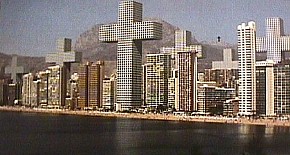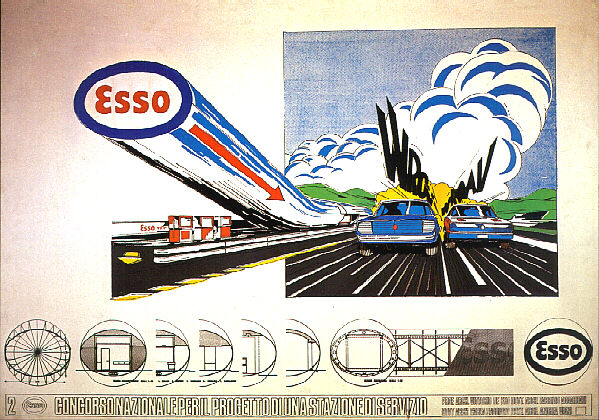2007.07.12 12:41
Sarcastic Architecture
sarcasm 1 : a keen or bitter taunt : a cutting gibe or rebuke often delivered in a tone of contempt or disgust
The overall tone of Part II of Learning from Las Vegas is not one of contempt or disgust.
For example:
"Many people like suburia. This is a compelling reason for learning from Levittown. The ultimate irony is that although Modern architecture from the start has claimed a strong social basis for its philosophy, Modern architects have worked to keep formal and social concerns separate rather than together. In dismissing Levittown, Modern architects, who have characteristically promoted the role of the social sciences in architecture, reject whole sets of dominant social patterns because they do not like the architectural consequences of these patterns."
--p. 154, 2nd edition
This sounds to me like solid critique rather than contempt or disgust. And the whole texts reads more of solid architectural (because the text really is so rich with just talking about architecture) critique then some sort of sarcastically based evil plot.
2007.07.12 22:33
Sarcastic Architecture
MVRDV have an interesting way of taking things/concepts to an extreme. Have they maybe learned from "Exodux, or the Voluntary Prisoners of Architecture"? I like their imagination nonetheless. A breed of Dutch sarcasm utilized when most useful?
"Holy Stations of the Cross, Batman!"

2007.07.18 08:35
on aesthetics
The fractured standard is just that, fractured. There is no universal, and indeed there never really was. Just look at what was going on (somewhat globally) in the early 1730s. There is no real universal standard, rather standards were then (and still are?) relative to place.
2007.07.18 09:37
on aesthetics
I'm not exactly sure how "any definition of place is going to be arbitrary."
There is a somewhat unquestioned methodology to architectural history, which categorizes types of architectures by period (time) and location (place). And this is mostly a Western European standard. Yet architectural history is rarely written where it demonstrates how types of architectures actually overlap when architecture is culled from all over the globe at any given time.
If you're not arbitary about place and simply say the globe, and then look to see what types of architecture were being done (on the globe) at any given time, you'll see just how diverse architecture always was. Interestingly, this is how we judge the present (and conclude that standards are fractured), but it's not how the past is/has been judged.
I agree that architecture for the most part is arbitrary in the sense that most architecture reflects a set of specific decisions (arbitration), but only a small percentage of architecture is outright whimsical. Personally, it's refreshing to see just how diverse architecture has always been.
Otherwise, the real modus operandi of aesthetics is "what is the cash value?"
| |
2007.08.04 14:41
Koolhaas & Eisenman Discuss "Urgency" at the CCA
About 180 more years of an architecture dominated by the combined assimilating and metabolic imaginations, and then roughly 500 years of an architecture dominated by a pure metabolic imagination. All the while the profane osmotic imagination remains in the background. So much for the physiology, morphologically a bi-polar structural network will continue to branch and grow (till completion c. 3091).
4706
2007.08.07 18:14
spreading like a virus... (discuss)
Both of the early New Harmony settlements were failures. And the second, under Robert Owen, was not exactly comprised by like minded individuals--there was definitely a class disparity.
One of the people that went to New Harmony with Owen was Hannah Fisher Price, and I happen to now live exactly where Hannah lived just before she went to New Harmony. After a couple of years at New Harmony, Hannah and her family moved to Cincinnati.
I'm finding the suburbs fascinating, and the ones around here are gorgeous.
2007.08.21 12:03
thesis... phenomenology
Le Corbusier's five points actually matured along with his oeuvre, and the promenade architecturale formula is often [executed] within the buildings as well. In many ways, Holl's work comprises an adroit riff off Ronchamp, Maison Jaoul and Cap Martin.
2007.08.21 17:05
Name that Architect and Building!!!
...you might be interested in looking through Arthur Drexler's Transformations in Modern Architecture (MoMA exhibition book, 1979). It's full of less well known 1960s-1970s buildings that look very inspiring today. Got a copy via eBay about a year ago and it's interesting to now look for images of the buildings online. I've been planning a 'reenactment' of the 1979 exhibition at Quondam for several months now. Looks like it will finally happen.
2007.08.23 15:59
Name that Architect and Building!!!
...here's a competition entry from 1971, prototype for an Esso Filling Station (obviously). Curious if anyone knows the architect. Otherwise, just want more people to know the project.

Vittorio De Feo, Fabrizio Aggarbati, Carla Saggioro, Andrea Vigni, Competition Project for a new Service Station, 1971.
| |
2007.10.04 11:06
things to do and see in MUNICH??
The Amalienburg in Nymphenburg Park--a rare manifestation of ultimate Rococo.

2007.10.04 13:13
Apocalyptic Urbanism
How much of New York City 1807 still exists today? How much of New York City 2007 will still exist in 2207?
2007.10.04 16:18
Apocalyptic Urbanism
Catastrophic urbanism might be a better term, and indeed New Orleans during and post hurricane Katrina provides an ample textbook on the subject. Pockets of civilization may well succumb to catatrophes, but the rest of civilization does just go on. At least that's the situation now, and probably for some time to come. Even the Great Tsunami 2004 had widespread effect, but still on only a small portion of civilization at large.
It's probably more worthwhile to contemplate catastrophic urbanism than to conjecture apocalyptic urbanism.
2007.10.14 17:52
Negative notes
"In Modern architecture we have operated too long under the restrictions of unbending rectangular forms supposed to have grown out of the technical requirements of the frame and the mass-produced curtain wall. In contrasting Mies' and Johnson's Seagram Building with Kahn's project for an office tower in Philadelphia it can be seen that Mies and Johnson reject all contradictions of diagonal wind-bracing in favor of an expression of a rectilinear frame. Kahn once said that the Seagram Building was like a beautiful lady with hidden corsets. Kahn, in contrast, expresses the wind-bracing--but at an expense of such vertical elements as the elevator and, indeed of the spaces for people."
--Robert Venturi, Complexity and Contradiction in Architecture (New York, MoMA, 1966), p. 56.
"Yet in City Tower, Kahn no more succeeded in making strides in architectural structure than he had in the Art Gallery at Yale. He erroneously discussed the project in tectonics terms, justifying City Tower's form by arguing that it best expressed buttressing against wind stresses: "The mind envisions a construction of a building growing from a base crossing its members as it rises against the forces of the wind." Yet neither Tyng nor Kahn checked their wind-stress argument with a structural engineer, who would have told them that because of the forces of gravity, a tower rising in a more-or-less straight vertical is dramatically more efficient."
--Sarah Williams Goldhagen, Louis Kahn's Situated Modernism (New Haven, Yale University Press, 2001), p. 78.
"Yes, architects sometimes used to make stuff up just to justify (the shape) their designs."
"What do you mean 'used to'?"
| |
2007.12.03 09:19
Guess Who
Both the profane and the sacred are human "being". Take away the qualifying hierarchy and you'll see the whole picture, which is much more.
After reading The Sacred and the Profane perhaps pick up Slovoj Zizek, The Puppet and the Dwarf: The Perverse Core of Christianity. It might help fill out the "whole picture."
...the subcategories of profane and sacred space:
fertile space
conceptual space
pregnant space
assimilating space
metabolic space
diaphragmic space
networked space
osmotic space
electromagnetic space
all-frequency space
for a school I'd go:
inside -- assimilating space and all-frquency space
outside -- metabolic space
2008.04.02 17:02
what is gothic that is not ornament? what is baroque, if not ornament?
Gothic is a passion play, whereas Baroque is a double theater.
2008.04.04 12:36
READING LIST
Currently reading Privacy and Publicity: Modern Architecture as Mass Media, and got up to p. 84 yesterday morning while waiting for the repair of an automatic car window. There is an unfortunate manuscript error on page 68:
lines 1-4
Benjamin cites a sentence of Theodor Reik... Remembrance is essentially conservative; memory is destructive."
lines 14-15
In these terms, Reik's distinction between conservative memory and destructive remembrance...
As they stand (at least in the 1994 hardback edition), these lines contradict each other, and thus completely confuse the issue. Now checking the source, lines 1-4 correctly recall Reik's distinction.
Staying on page 68, I (personally) use/translate Erfahrung as 'a knowledge of', and Erlebnis as 'an actual experience of', in the sense that Erfahrung is more or less a reenactment of Erlebnis.
2008.04.28 10:28
the state of drawing in education
"The third phase is distinguished from the second only because in the later period the number of partial images is increased as much as possible to create the effect of infinitely more images."
Frankl, Principles of Architectural History, p. 152.
2008.05.15 07:49
Eisenman's six point plan
Eisenman's points/arguments here are either flawed in logic, sentimental, academic, or self-serving. For example, "students are passive," yet the students described here are actually protesting. In terms of practice, deconstruction is one of architecture's most obscure styles and 'post-modernism' is still what the vast majority of architects do. Part of what's historically playing out now is Le Corbusier's late style and Kahn's early 'planning' style.
Anyone else love watching Boston Legal. Now there's a style architecture would do well to emulate.
|